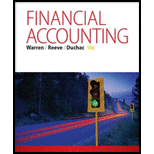
Recognizing pension expense
The annual examination of Felton Company’s financial statements by its external public accounting firm (auditors) is nearing completion. The following conversation took place between the controller of Felton Company (Francie) and the audit manager from the public accounting firm (Sumana):
Sumana: You know, Francie, we are about to wrap up our audit for this fiscal year. Yet, there is one item still to be resolved.
Francie: What’s that?
Sumana: Well, as you know, at the beginning of the year, Felton began a defined benefit pension plan. This plan promises your employees an annual payment when they retire, using a formula based on their salaries at retirement and their years of service. I believe that a pension expense should be recognized this year, equal to the amount of pension earned by your employees.
Francie: Wait a minute. I think you have it all wrong. The company doesn’t have a pension expense until it actually pays the pension in cash when the employee retires. After all, some of these employees may not reach retirement, and if they don’t, the company doesn’t owe them anything.
Sumana: You’re not really seeing this the right way. The pension is earned by your employees during their working years. You actually make the payment much later—when they retire. It’s like one long accrual—much like incurring wages in one period and paying them in the next. Thus, I think you should recognize the expense in the period the pension is earned by the employees.
Francie: Let me see if I’ve got this straight. I should recognize an expense this period for something that may or may not be paid to the employees in 20 or 30 years, when they finally retire. How am I supposed to determine what the expense is for the current year? The amount of the final retirement depends on many uncertainties: salary levels, employee longevity, mortality rates, and interest earned on investments to fund the pension. I don’t think an amount can be determined even if I accepted your arguments.
 Evaluate Sumana’s position. Is she right, or is Francie correct?
Evaluate Sumana’s position. Is she right, or is Francie correct?
Trending nowThis is a popular solution!

Chapter 11 Solutions
Financial Accounting
- Can you help me solve this general accounting question using valid accounting techniques?arrow_forwardI am trying to find the accurate solution to this general accounting problem with appropriate explanations.arrow_forwardI need guidance with this general accounting problem using the right accounting principles.arrow_forward
- I need guidance with this general accounting problem using the right accounting principles.arrow_forwardPlease provide the answer to this general accounting question using the right approach.arrow_forwardI need help with this general accounting question using standard accounting techniques.arrow_forward
- Current Attempt in Progress The following transactions involving intangible assets of Oriole Corporation occurred on or near December 31, 2025. 1. 2. Oriole paid Grand Company $520,000 for the exclusive right to market a particular product, using the Grand name and logo in promotional material. The franchise runs for as long as Oriole is in business. Oriole spent $654,000 developing a new manufacturing process. It has applied for a patent, and it believes that its application will be successful. 3. 4. 5. 6. In January 2026, Oriole's application for a patent (#2 above) was granted. Legal and registration costs incurred were $247,800. The patent runs for 20 years. The manufacturing process will be useful to Oriole for 10 years. Oriole incurred $168,000 in successfully defending one of its patents in an infringement suit. The patent expires during December 2029. Oriole incurred $446,400 in an unsuccessful patent defense. As a result of the adverse verdict, the patent, with a remaining…arrow_forwardPlease explain the solution to this general accounting problem with accurate explanations.arrow_forwardI am searching for the correct answer to this general accounting problem with proper accounting rules.arrow_forward
 Financial AccountingAccountingISBN:9781337272124Author:Carl Warren, James M. Reeve, Jonathan DuchacPublisher:Cengage Learning
Financial AccountingAccountingISBN:9781337272124Author:Carl Warren, James M. Reeve, Jonathan DuchacPublisher:Cengage Learning Intermediate Accounting: Reporting And AnalysisAccountingISBN:9781337788281Author:James M. Wahlen, Jefferson P. Jones, Donald PagachPublisher:Cengage Learning
Intermediate Accounting: Reporting And AnalysisAccountingISBN:9781337788281Author:James M. Wahlen, Jefferson P. Jones, Donald PagachPublisher:Cengage Learning Auditing: A Risk Based-Approach (MindTap Course L...AccountingISBN:9781337619455Author:Karla M Johnstone, Audrey A. Gramling, Larry E. RittenbergPublisher:Cengage Learning
Auditing: A Risk Based-Approach (MindTap Course L...AccountingISBN:9781337619455Author:Karla M Johnstone, Audrey A. Gramling, Larry E. RittenbergPublisher:Cengage Learning



